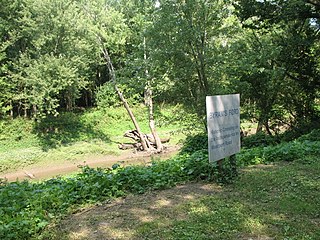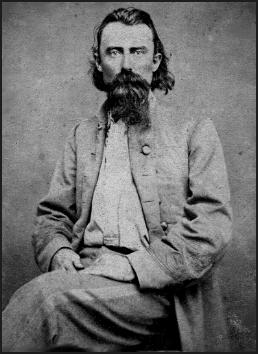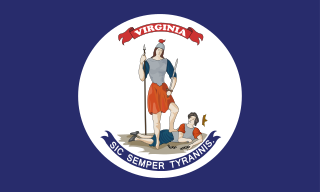Related Research Articles

The Battle of Westport, was fought on October 23, 1864, in modern Kansas City, Missouri, during the American Civil War. Union forces under Major General Samuel R. Curtis decisively defeated an outnumbered Confederate force under Major General Sterling Price. This engagement was the turning point of Price's Missouri Expedition, forcing his army to retreat. The battle ended the last major Confederate offensive west of the Mississippi River, and for the remainder of the war the United States Army maintained solid control over most of Missouri. This battle was one of the largest to be fought west of the Mississippi River, with over 30,000 men engaged.
The Battle of Fort Davidson, also known as the Battle of Pilot Knob, was a battle of Price's Missouri Expedition fought on September 27, 1864, near Pilot Knob, Missouri. Confederate troops under the command of Major-General Sterling Price had entered Missouri in September 1864 with hopes of challenging Union control of the state. On September 24, Price learned that Union troops held Pilot Knob. Two days later, he sent part of his command north to disrupt and then moved towards Pilot Knob with the rest of his army. The Confederate divisions of Major-General James Fagan and Brigadier-General John Marmaduke drove Union troops under Brigadier-General Thomas Ewing and Major James Wilson from the lower Arcadia Valley into Fort Davidson on September 26 and on the morning of September 27.

The Second Battle of Independence was fought on October 22, 1864, near Independence, Missouri, as part of Price's Raid during the American Civil War. In late 1864, Major General Sterling Price of the Confederate States Army led a cavalry force into the state of Missouri, hoping to create a popular uprising against Union control, draw Union Army troops from more important areas, and influence the 1864 United States presidential election.

The Battle of Little Blue River was fought on October 21, 1864, as part of Price's Raid during the American Civil War. Major General Sterling Price of the Confederate States Army led an army into Missouri in September 1864 with hopes of challenging Union control of the state. During the early stages of the campaign, Price abandoned his plan to capture St. Louis and later his secondary target of Jefferson City. The Confederates then began moving westwards, brushing aside Major General James G. Blunt's Union force in the Second Battle of Lexington on October 19. Two days later, Blunt left part of his command under the authority of Colonel Thomas Moonlight to hold the crossing of the Little Blue River, while the rest of his force fell back to Independence. On the morning of October 21, Confederate troops attacked Moonlight's line, and parts of Brigadier General John B. Clark Jr.'s brigade forced their way across the river. A series of attacks and counterattacks ensued, neither side gaining a significant advantage.

The Battle of Byram's Ford was fought on October 22 and 23, 1864, in Missouri during Price's Raid, a campaign of the American Civil War. With the Confederate States of America collapsing, Major General Sterling Price of the Confederate States Army conducted an invasion of the state of Missouri in late 1864. Union forces led Price to abandon goals of capturing the cities of St. Louis and Jefferson City, and he turned west with his army towards Kansas City.

Joseph Orville "J.O." Shelby was a Confederate officer who commanded cavalry in the Trans-Mississippi Theater of the American Civil War. After the Confederacy surrendered, Shelby tried to swear fealty to Emperor Maximilian I during the French invasion of Mexico. With the Emperor's permission, Shelby formed a colony of Confederate exiles in Mexico until the defeat of the French, then abandoned the operation.

Price's Missouri Expedition, also known as Price's Raid or Price's Missouri Raid, was an unsuccessful Confederate cavalry raid through Arkansas, Missouri, and Kansas in the Trans-Mississippi Theater of the American Civil War. Led by Confederate Major General Sterling Price, the campaign aimed to recapture Missouri and renew the Confederate initiative in the larger conflict.
The Battle of Athens was an American Civil War skirmish that took place in northeast Missouri in 1861 near present-day Revere and southeast Iowa along the Des Moines River across from Croton. The Union victory has the distinction of being the most northerly of Civil War Battles fought west of the Mississippi, and also of being the only such battle fought along the Iowa border.

The Colorado Territory was formally created in 1861 shortly before the bombardment of Fort Sumter sparked the American Civil War. Although sentiments were somewhat divided in the early days of the war, Colorado was only marginally a pro-Union territory. Colorado was strategically important to both the Union and Confederacy because of the gold and silver mines there as both sides wanted to use the mineral wealth to help finance the war. The New Mexico Campaign was a military operation conducted by Confederate Brigadier General Henry Sibley to gain control of the Southwest, including the gold fields of Colorado, the mineral-rich territory of Nevada and the ports of California. The campaign was intended as a prelude to an invasion of the Colorado Territory and an attempt to cut the supply lines between California and the rest of the Union. However, the Confederates were defeated at the Battle of Glorieta Pass in New Mexico and were forced to retreat back to Texas, effectively ending the New Mexico Campaign.

The state of Iowa played a significant role during the American Civil War in providing food, supplies, troops and officers for the Union army.

Shelby's Iron Brigade, also known as the Missouri Iron Brigade, was a Confederate cavalry brigade, led by Brigadier General Joseph O. Shelby, in the Trans-Mississippi Theater of the American Civil War.

The area that eventually became the U.S. state of Montana played little direct role in the American Civil War. The closest the Confederate States Army ever came to the area was New Mexico and eastern Kansas, each over a thousand miles away. There was not even an organized territory using "Montana" until the Montana Territory was created on May 26, 1864, three years after the Battle of Fort Sumter. In 1861, the area was divided between the Dakota Territory and the Washington Territory, and in 1863, it was part of the Idaho Territory.

The 2nd Virginia Cavalry Regiment was a cavalry regiment raised in Virginia for service in the Confederate States Army during the American Civil War. It fought mostly with the Army of Northern Virginia.

The 1st Northeast Missouri Cavalry, or 1st NE Missouri Cavalry was a Confederate Army regiment during the American Civil War. One of the commanders was Colonel Joseph C. Porter, who led 125 men through the Battle of Moore's Mill. This regiment was known for its guerrilla warfare.

The Battle of Fairfax Court House was fought during the Gettysburg Campaign of the American Civil War between two cavalry detachments from the Union Army of the Potomac, commanded by General Joseph Hooker, and the Confederate Army of Northern Virginia, commanded by General Robert E. Lee.
Slayback's Missouri Cavalry Regiment was a cavalry regiment of the Confederate States Army during the American Civil War. Originally formed as Slayback's Missouri Cavalry Battalion, the unit consisted of men recruited in Missouri by Lieutenant Colonel Alonzo W. Slayback during Price's Raid in 1864. The battalion's first action was at the Battle of Pilot Knob on September 27; it later participated in actions at Sedalia, Lexington, and the Little Blue River. In October, the unit was used to find an alternate river crossing during the Battle of the Big Blue River. Later that month, Slayback's unit saw action at the battles of Westport, Marmiton River, and Second Newtonia. The battalion was briefly furloughed in Arkansas before rejoining Major General Sterling Price in Texas in December. Likely around February 1865, the battalion reached official regimental strength after more recruits joined.
The capture of Sedalia occurred during the American Civil War when a Confederate force captured the Union garrison of Sedalia, Missouri, on October 15, 1864. Confederate Major General Sterling Price, who was a former Governor of Missouri and had commanded the Missouri State Guard in the early days of the war, had launched an invasion into the state of Missouri on August 29. He hoped to distract the Union from more important areas and cause a popular uprising against Union control of the state. Price had to abandon his goal of capturing St. Louis after a bloody repulse at the Battle of Fort Davidson and moved into the pro-Confederate region of Little Dixie in central Missouri.
Nichols's Missouri Cavalry Regiment served in the Confederate States Army during the late stages of the American Civil War. The cavalry regiment began recruiting in early 1864 under Colonel Sidney D. Jackman, who had previously raised a unit that later became the 16th Missouri Infantry Regiment. The regiment officially formed on June 22 and operated against the Memphis and Little Rock Railroad through August. After joining Major General Sterling Price's command, the unit participated in Price's Raid, an attempt to create a popular uprising against Union control of Missouri and draw Union troops away from more important theaters of the war. During the raid, while under the command of Lieutenant Colonel Charles H. Nichols, the regiment was part of an unsuccessful pursuit of Union troops who were retreating after the Battle of Fort Davidson in late September.

The Battle of McGuire's Store was fought at McGuire, Arkansas, near Elkins, between Union forces led by Brigadier General Francis J. Herron and Confederate forces under Colonel Jesse L. Cravens during the American Civil War. The skirmish was the result of an attempt by Union Brigadier General John Schofield to trap a body of Confederate cavalry reported to be at McGuire's Store. In the event, the operation failed when Herron's column took the wrong road and approached from the west instead of the north. Herron's well-equipped troops attacked Cravens' poorly armed and demoralized Texas cavalrymen and drove them off. This minor clash and other events caused Confederate Major General Thomas C. Hindman to suspend his intended advance to recover northwestern Arkansas and withdraw to the Arkansas River. Ironically, most of Schofield's soldiers also retreated to Missouri after the fight. Though the clash was minor, it marked one pulse of the ebb and flow of the war in northwest Arkansas.